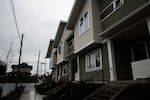Julia Metz stands on a sidewalk in Northeast Portland’s Woodlawn neighborhood, pointing across the street to a triplex that stands out next to a long line of single-family houses stretching down the block.
“We replaced one home and were able to provide three homes instead on the same-sized lot,” said Metz, who works at Portland Community Reinvestment Initiatives, a non-profit that developed and manages the homes.
“We were able to get family-sized homes in there,” she said in a proud tone. "Three bedrooms, 1 1/2 baths in each of them.”

A new triplex is pictured on the corner of Northeast Sixth Avenue and Northeast Ainsworth Street Friday, Feb. 1, 2019, in Portland, Ore. A bill in the state Legislature would change single-family zoning rules to allow more buildings like this in cities looking to grow more dense.
Jeff Mapes / OPB
This is a prime example of the kind of housing that House Speaker Tina Kotek, D-Portland, wants to see scattered throughout neighborhoods that have been zoned exclusively for single-family homes.
The powerful lawmaker has introduced House Bill 2001, which would require every city of more than 10,000 and county of at least 15,000 to allow so-called "middle-housing" in residential neighborhoods within their urban growth boundary. She's talking about two, three and four-unit homes. She also wants to encourage cottage clusters – small units grouped around a central courtyard – small accessory units added to homes and more liberal rules allowing existing homes to be subdivided.
Related: Oregon Legislative Preview: Democrats In Charge With Ambitious Agenda
Her legislation is one of the more eye-catching initiatives being pursued by Democratic legislative leaders to cope with Oregon’s big housing shortage. They are also promoting bills establishing rent control, low-income housing subsidies and programs to reduce homelessness.
But this is their major attempt to spur market forces to increase the state’s supply of housing – which by one estimate falls more than 150,000 units short of demand.
“We didn’t build enough during the recession,” said Kotek, “and we really need to talk about how we provide more choice, how do we provide more options.”
It’s too early to tell what kind of reception will meet Kotek’s bill, which has its first hearing on Monday, Feb. 11.
Critics have already raised concerns about taking power away from communities to develop their own zoning rules. And some skeptics say Oregon should instead focus on loosening its statewide land use laws to allow more new housing construction on the urban fringes.
But the biggest unknown is how voters will react to the idea of changing the feel of single-family neighborhoods – which by far dominate the landscape of the state’s one major metropolitan area and its smaller cities as well.
“This is a conversation for Oregon,” said Rep. Alissa Keny-Guyer, D-Portland, who chairs the House Committee on Human Services and Housing. “What do we want our cities to look like in 50 years?”
In the decades following World War II, tracts of detached homes paired with green lawns and garages became an iconic part of the American dream. But the primacy of the single-family house is being re-thought, particularly in rapidly growing cities where housing prices are skyrocketing.
In California, a new YIMBY movement – Yes In My Back Yard – is pushing legislators to ease zoning restrictions. Minneapolis recently ended exclusive single-family zoning. Several Oregon cities are also getting into the act.
Tigard recently changed its zoning rules to allow a range of multi-family options in residential neighborhoods. Ditto for Bend, which is opening additional neighborhoods to duplexes and triplexes.
Most notably, Portland has launched a residential infill project that would allow denser development throughout much of the inner eastside and smaller parts of the westside.
Oregonians “need to start thinking about what family housing is like differently than that four bedroom, 2 1/2 bathrooms on its own lot, in a neighborhood filled with just that,” said Mary Kyle McCurdy, deputy director of 1000 Friends of Oregon.
Her group – founded to fight suburban sprawl – is helping put together the coalition to push for Portland's residential infill project, and for Kotek's bill as well. Supporters of such changes say single-family zoning was in part aimed at excluding people of color. And they say that the continuation of strict zoning rules make a mockery of those President Trump-era signs that have popped up, particularly around Portland, expressing welcome for a wide variety of people.

Minority Leader Carl Wilson and Speaker of the House Tina Kotek pose for a group photo during the opening of the 2019 Oregon legislative session in Salem, Ore., Monday, Jan. 14, 2019.
Bradley W. Parks / OPB
“A lot of time, the folks who are able to own the homes in [single-family] neighborhoods are white families that have had generations of access to home ownership opportunities and the wealth that comes with that,” said Metz, the housing official at Portland Community Reinvestment Initiatives.
But at a marathon hearing before the Portland Planning and Sustainability Commission last May, numerous homeowners complained about the residential infill project.
“Higher density tends to decrease livability,” Robert Webb said. “It translates to less green space, fewer trees, loss of privacy, loss of views, more noise and traffic.”
Margaret Davis cited one study saying that the single-family detached home is the “most desirable housing type” and asked: “Why tear it down?”
Shaun Jillions, a lobbyist for the Oregon Association of Realtors, said he has talked with Kotek’s staff about potential concerns about some of the details of her bill. But he also warned that the push to expand what’s allowed could ignite fervent opposition in the suburbs.
“There’s a reason people move out there,” he said. “They want a single-family detached house in a neighborhood with a bunch of kids. They don’t want a four-plex right there with eight cars now piled out in the street.”
Related: Oregon Lawmakers Are Preparing For Another Federal Shutdown
Kevin Hoar, an Oregon Republican Party official who has followed zoning battles in his unincorporated Washington County community north of Beaverton, said this bill exacerbates the difficulty Oregon has in meeting the demand for affordable single-family homes.
“Should the state be deciding what the American dream, or the Oregonian dream is? Or should homebuyers, home sellers and the localities that zone them be deciding that?” Hoar said.
He said the state should instead make it easier to expand the urban growth boundary. Under Oregon’s state land-use laws, the boundaries are supposed to contain enough land for a 20-year housing supply.
Jodi Hack, a lobbyist for the Oregon Home Builders Association, said her group supports easing rules for multi-family development in urban areas. But she said she wants an amendment to Kotek’s bill making it clear that up-zoning existing single-family neighborhoods wouldn’t change the calculations for expanding the growth boundary – at least not until it becomes clear how much extra development results.
Kotek said she wants to set aside the issue of boundary expansions while considering the bill. But it’s clear that she and other supporters also are committed to compact development.
“Blowing open the urban growth boundary,” Kotek said, “is a value most Oregonians don’t want. They want us to have controlled land-use policies.”
Kotek and other supporters say attitudes about the ideal neighborhood are changing. Seniors want more housing choices so they can stay nearby in smaller spaces that are easier to maintain. Millennials are more likely to value walkable neighborhoods near their jobs, restaurants and other amenities – and they are less likely to be able to afford a spacious house and yard.
The House speaker said she’s trying to return to the mixture of housing once common in American cities. She fondly remembers living in a cottage apartment in one of Portland’s older neighborhoods.
“You had mixed income communities living side by side,” Kotek said, “and I think that’s where we want to be.”
Mike Kingsella heads the Up for Growth National Coalition in Washington, D.C., which recently published an economic study estimating that Oregon fell 155,000 homes short of meeting demand from 2000 to 2015.
Kingsella said he understands the desire to preserve the character of your surrounding neighborhood. But he said the current path is unsustainable in rapidly growing cities.
“We have skyrocketing housing prices,” he said, “we have a whole generation that is more and more locked out of home ownership because of the lack of availability of housing in these high-opportunity single-family neighborhoods. And so something has to give.”